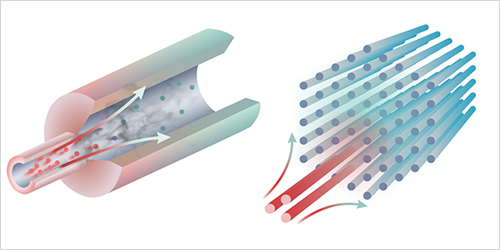Chill out – Relaxation lets powerful laser beams get into shape
15.01.2025

Inspired by thermodynamics, researchers from the Universites of Rostock and Southern California have developed a novel technique to shape the flow of light and efficiently combine powerful laser beams. Their discovery has been published online by the renowned journal “Nature Physics” on January 15, 2025.
Since cave people first harnessed fire to fend off dangerous predators and to illuminate their otherwise dark dwellings, light and heat have been our constant companions. The ability to harness fire as source of heat and light has driven the development of humankind from those humble beginnings to a spacefaring civilization. Light has traditionally been understood as (inarguably useful) byproduct as well as a carrier of heat. “Children quickly find out that the flame of a candle is better left untouched. Similarly, experimental physicists learn to keep their fingers out of laser beams,” quips Prof. Alexander Szameit of the University of Rostock. Yet, the connection between the sciences of heat (Thermodynamics) and light (Optics) reaches far deeper, as was recently discovered by Prof. Demetrios Christodoulides and his team at the University of Southern California in Los Angeles: The same laws that govern the interplay of temperature, pressure and volume in gases can be used to describe how high-power laser beams evolve in complex structures.
One of the hallmark processes in thermodynamics is the so-called Joule-Thomson expansion. Dr. Matthias Heinrich, senior researcher in Szameit’s group, elaborates: “Imagine an aerosol can. Upon exiting the nozzle, gas that had previously been contained at room temperature under immense pressure is released. It freely expands to ambient pressure and, in doing so, cools down substantially.” On a microscopic scale, the interactions between the individual molecules of the expanding gas can lead to an irreversible conversion of energy. In other words, once expanded and cooled down, the increasing degree of disorder (entropy) prevents the gas from voluntarily reverting back to its initial state.
In close collaboration with colleagues in Los Angeles and Orlando, the Rostock scientists were able to recreate this process for intense laser light. Although light beams can famously pass through one another, this no longer holds true at higher powers where the presence of a beam temporarily alters the properties of the medium it propagates in. As a result, more light is not just brighter, but indeed behaves differently. “On a very abstract level, this nonlinear behavior is reminiscent of the interactions of gas molecules. The result is however quite tangible,” first author Marco Kirsch describes the starting point of his work. What the scientists interpret as ‘temperature’ of the light beam has nothing to do with how hot it would feel to the touch. Instead, it describes the shape of the beam. Kirsch continues: “By letting a disordered light distribution ‘expand’ into a larger system such as a multicore optical fiber, the light ‘cools down’ and, in doing so, rearranges itself into a clean beam.” By extension, even the input from multiple independent laser sources can be combined in a self-organized fashion with high efficiency and virtually no need for active modulation – a long-standing challenge in laser engineering.
The successful international collaboration has substantially advanced fundamental research in the emerging field optical thermodynamics. While it may be some time until these insights will find their way into industrial applications, the physicists’ newest discovery has great potential for a wide range of innovative approaches such as the photonic equivalent of thermal engines and heat pumps for light.
This research was funded by Deutsche Forschungsgemeinschaft and the Alfried Krupp von Bohlen und Halbach-Foundation.
Publication: M. S. Kirsch et al., “Observation of Joule–Thomson photon-gas expansion,” Nature Physics, https://doi.org/10.1038/s41567-024-02736-1 (2025)
Contact:
Prof. Alexander Szameit
Experimental Solid-State Optics Group
Institute of Physics University of Rostock
Tel.: +49 381 498-6790
E-Mail: alexander.szameit@uni-rostock
